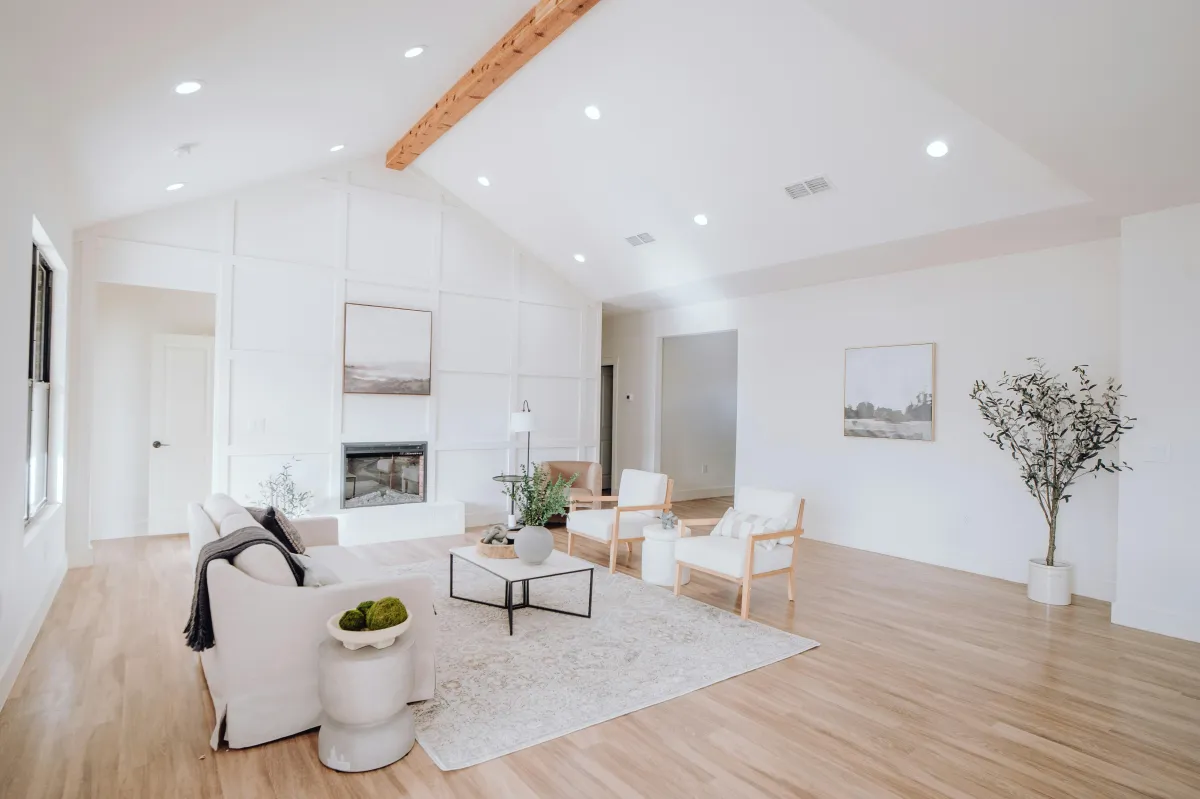
Renovate or Rebuild? Why Smart Homeowners Choose Renovation
When it comes to creating your dream home, the choice between renovation and new construction is a big one. Renovating offers a unique opportunity to preserve a home’s character while upgrading functionality and efficiency. It often comes with shorter timelines, fewer permits, and lower upfront costs. On the other hand, building new provides full customization but requires a more substantial investment and longer planning. Each path has its benefits, depending on your goals, location, and budget. Custom Builder Connection helps homeowners navigate these options with expert guidance and trusted professionals.
Key Takeaways
Renovation maintains a home’s charm while modernizing essential systems and boosting resale value.
Renovation projects are generally more cost-effective and quicker to complete than building from scratch.
Sustainable practices like material reuse and system upgrades make renovation an eco-friendly choice.
ROI varies by project, but renovations often yield high returns, especially in kitchens and bathrooms.
Custom Builder Connection connects homeowners with professionals who align with project goals, region, and budget.
What Are the Key Benefits of Renovating Your Home Compared to Building New?

Renovating a home lets you leverage existing architectural features and history while boosting property value. By updating interiors and exteriors, homeowners maintain a home’s charm and character while upgrading essential systems such as plumbing, electrical, and insulation. This process reduces demolition waste and can be more environmentally friendly compared to new construction.
How Does Renovation Increase Property Value and Preserve Architectural Style?
Renovation enhances market value by modernizing outdated spaces while retaining the home’s original charm. Preserving key architectural elements like arched doorways, ceiling beams, or original floors adds character and emotional appeal. Upgrading with modern, energy-efficient systems improves functionality without sacrificing style. Thoughtful renovations can attract buyers looking for unique homes with updated interiors. Strategic improvements like lighting, ventilation, and layout updates boost comfort and performance. Enhancements also align the home with current market preferences. These upgrades often yield strong resale value. The balance of history and innovation makes renovated homes stand out.
In What Ways Is Renovation More Cost-Effective Than New Construction?
Renovating is typically more affordable because it builds on existing infrastructure. This avoids expenses like excavation, structural framing, and full mechanical installs. Materials such as cabinetry, flooring, or wall systems may be repurposed or upgraded instead of replaced. Cost-effective phasing lets homeowners tackle improvements in stages, matching their budget. Utility lines and foundations often remain intact, reducing major setup costs. The renovation process also allows more control over spending per room. Labor expenses may be lower due to reduced scale. Overall, renovation offers high impact with more manageable investment.
How Does Renovation Support Sustainable and Eco-Friendly Practices?
Renovation minimizes waste by reusing existing materials and structures. Updating insulation, windows, and air sealing improves energy conservation and indoor air quality. Using low-VOC paints and reclaimed wood contributes to healthier interiors. Selective upgrades reduce the need for large-scale demolition, preserving usable elements. Incorporating solar panels or energy-efficient systems further lowers utility consumption. Sustainable renovations also reduce transportation needs for new materials. Renovating avoids excessive landfill waste from tear-downs. Together, these practices support long-term environmental responsibility.
How Do Renovation and New Construction Costs Compare?

Renovation tends to cost less overall because it focuses on updates instead of full builds. Many core systems—like plumbing, foundations, or walls—can be retained and upgraded. In contrast, new construction requires complete structural assembly and new utilities. Renovation budgets are often more flexible, with costs spread over time. New construction typically requires higher upfront investment due to scope. Labor and permitting costs are generally lower for renovations. Material use is more efficient when adapting existing spaces. Renovation aligns well with homeowners seeking cost-conscious improvements.
What Are the Typical Cost Components of Renovation Projects?
Renovation costs are divided among design updates, labor, materials, and unexpected issues. Structural work like framing, drywall, or flooring repairs may be necessary. Mechanical systems such as HVAC or electrical upgrades account for a portion of the budget. Materials range from basic finishes to energy-efficient products and eco-friendly fixtures. Labor includes licensed contractors for carpentry, plumbing, and painting. Permit and inspection fees also contribute to the total cost. Contingency funds are essential for handling surprises. A balanced budget ensures smoother project execution.
How Do New Construction Costs Break Down by Materials, Labor, and Permits?
New construction costs typically start with major investments in raw materials for the structure, exterior, and systems. Labor costs cover framing, electrical, plumbing, and finishing trades throughout the build. Permit and architectural design fees add to early-stage expenses. Full-site development, such as grading and utility installation, is also required. New builds must meet current code across all systems, adding compliance costs. Advanced materials like insulation and roofing impact pricing based on specifications. Larger-scale projects tend to have longer labor durations. Altogether, this results in higher upfront costs compared to renovations.
What Are the Timeline Differences Between Renovation and New Construction?

Renovation projects generally move faster due to smaller scope and use of existing structures. Fewer design phases and shorter permitting cycles often reduce delays. New construction requires full design development, site prep, and multi-stage approvals. Larger teams and full system installations also extend build times. Weather, inspections, and sequencing can add more weeks to new builds. Renovations, on the other hand, allow partial occupancy during updates. Faster project completion can lower living costs and stress. Timelines are a key consideration when comparing both approaches.
How Long Does a Typical Renovation Take Compared to Building New?
Small- to mid-sized renovations may take a few weeks to several months. More extensive home improvement projects can range up to 6–12 months depending on complexity. In contrast, new construction timelines often span 8–18 months, especially when custom design is involved. Renovations benefit from existing infrastructure, reducing lead times. Delays in new construction may occur from weather, permit holdups, or inspections. Site accessibility and scope also influence build duration. A renovation’s faster schedule is often a deciding factor for budget-conscious or time-sensitive homeowners. Each timeline should match personal needs and project goals.
What Factors Can Accelerate or Delay Renovation Projects?
Efficient contractors and pre-approved materials can speed up the renovation timeline. Fast approvals and clear project scopes also help avoid unexpected hold-ups. However, delays often occur from hidden damage behind walls or under flooring. Supply chain issues may impact access to key items like light fixtures or HVAC components. Permit processing or code compliance reviews can extend the timeline. Unclear communication between teams may also lead to errors or rework. A contingency plan helps absorb timeline shifts without escalating costs. Being proactive and organized is key to keeping renovation projects on schedule.
How Does New Construction Timeline Affect Homeowner Planning?
Longer new construction timelines require advanced planning for living arrangements and financial readiness. Homeowners may need temporary housing during the build process. Extended schedules also demand more detailed budgeting and loan coordination. Permitting stages, weather interruptions, and inspections add layers of uncertainty. Delays can shift move-in dates significantly, especially with custom designs. Flexible timelines help accommodate these phases without stress. Homeowners should work with professionals to establish realistic completion windows. Preparation is essential when navigating the complexities of building new.
How Do Renovation and New Construction Compare in Terms of Sustainability and Energy Efficiency?

Renovations support sustainability by repurposing existing structures and reducing construction waste. Projects can upgrade insulation, windows, and systems without full-scale demolition. New construction, however, allows integration of advanced sustainable technologies from the outset. Both approaches improve efficiency with smart thermostats, LED lighting, and efficient HVAC systems. The renovation route typically results in lower embodied carbon through material reuse. New homes can achieve higher performance standards through building envelope design. The right choice depends on current property conditions and environmental goals. Both paths can align with sustainable living if planned intentionally.
What Sustainable Materials and Practices Are Common in Renovations?
Renovations often use reclaimed or recycled materials that reduce demand for new resources. Common choices include recycled tile, low-VOC paint, and reclaimed wood flooring. Eco-friendly insulation and energy-efficient fixtures improve comfort and performance. Upgrading old windows or sealing air leaks helps reduce heat loss and energy use. Lighting updates to LED systems further lower operational costs. Sustainable practices may also include water-saving fixtures and improved ventilation. These choices benefit both indoor air quality and long-term utility savings. Thoughtful materials contribute to greener, healthier homes.
How Does New Construction Incorporate Energy-Efficient Technologies?
New construction provides the opportunity to design for efficiency from the ground up. Builders can install advanced insulation, airtight duct systems, and energy-efficient HVAC units. High-performance windows, LED lighting, and smart thermostats can be integrated during planning. New homes may also feature green roofs, solar panels, or energy monitoring systems. Layouts can optimize airflow and daylight use to reduce reliance on artificial lighting. Material selection can target low-emission, sustainable options. Entire systems are built with efficiency as a core focus. This makes new construction ideal for long-term energy savings and performance.
Which Option Offers Greater Environmental Benefits Over Time?
Both renovation and new construction offer long-term environmental gains depending on the project approach. Renovation reduces demolition waste and reuses existing materials, minimizing resource extraction. Energy upgrades like efficient lighting, insulation, and window replacements improve performance. New construction enables the integration of cutting-edge technology and advanced sustainable systems. Over time, both paths can reduce energy use, emissions, and utility costs. The best option depends on site condition, budget, and sustainability goals. With proper planning, either route can support eco-conscious living. Prioritizing energy conservation makes a lasting impact.
What Is the Return on Investment (ROI) for Renovation Versus New Construction?

Renovations can quickly boost a home’s value, often recouping expenses through increased resale value. New construction, though more costly, may offer long-term financial benefits through modern features and lower operating costs. ROI depends on market trends, project scope, and local demand.
How Does Renovation ROI Vary by Project Type and Scope?
Return on investment varies based on which areas of the home are renovated. Kitchen and bathroom remodels tend to offer the highest returns due to their functional value. Exterior improvements like siding or roofing may provide more modest gains. ROI is influenced by the materials used, craftsmanship, and regional market conditions. Layout improvements and energy efficiency upgrades also add measurable value. Homeowners often see better returns when changes align with current buyer preferences. Staged renovations may build equity over time. Tracking these returns helps guide future project planning.
What Are the Long-Term Financial Benefits of New Construction?
New construction offers financial benefits like lower maintenance costs and increased energy efficiency. New homes often include modern systems that require fewer repairs in the early years. Energy-efficient appliances and insulation reduce monthly utility bills. Custom layouts also minimize future remodeling needs, saving on future renovation expenses. High-performing homes often appeal to buyers seeking sustainable features. Over time, these advantages contribute to long-term cost savings. The total investment is higher up front, but future expenses are typically more predictable. Financial planning should account for these differences.
How Do Market Trends Affect ROI for Both Options?
Shifting market preferences can influence which investment offers better returns. In areas where historic character is valued, renovations that preserve charm may see higher ROI. New construction often performs well in growing neighborhoods where buyers seek customization. Energy-efficient features are increasingly in demand and boost value for both approaches. Local real estate trends and buyer expectations shape perceived value. The resale market responds to how well a property meets current lifestyle needs. Monitoring trends helps homeowners make strategic choices. Both renovation and new builds benefit from thoughtful timing.
Frequently Asked Questions
What is the primary advantage of home renovation over new construction?
Home renovation allows homeowners to retain the character of an existing property while making targeted updates to improve functionality, comfort, and value. It typically requires less time, fewer permits, and lower upfront costs than building from scratch—making it ideal for those who want to enhance their living space without starting over.
How long do renovation projects usually take compared to new construction?
Renovation projects often take a few weeks to several months depending on scope, while new construction typically spans 8 to 18 months. Since renovations work within existing structures, they involve fewer delays and faster turnaround. Custom Builder Connection helps homeowners find experienced professionals who can streamline renovation timelines.
Can renovating a property improve its energy efficiency?
Yes, renovations can significantly boost a home's energy efficiency by upgrading insulation, windows, HVAC systems, and lighting. Homeowners can also integrate smart thermostats and energy-efficient appliances, reducing utility costs and improving comfort. These improvements make existing homes more sustainable and cost-effective over time.
What financing options are available for home renovations?
Common renovation financing options include home equity loans, HELOCs (Home Equity Lines of Credit), personal loans, and green energy incentives. Some homeowners may also qualify for local or government-backed programs supporting sustainable upgrades. Custom Builder Connection helps match clients with professionals who understand how to plan projects within various financing frameworks.
How do regional factors affect both renovation and new construction costs?
Labor rates, material availability, climate conditions, and local building codes all influence cost. Urban areas may have higher permit fees and contractor pricing, while rural regions may offer affordability but face logistical challenges. Custom Builder Connection considers these factors when connecting homeowners with professionals best suited for their location and budget.
Conclusion
Both renovation and new construction offer unique value depending on your priorities. Renovation stands out for its ability to blend character with modern updates, often at a lower cost and with less disruption. New construction may appeal to those seeking full customization and long-term energy performance. Custom Builder Connection ensures homeowners receive the right support, whether they choose to remodel or build new. By matching clients with vetted professionals, CBC simplifies the process from planning to completion. Whatever your path, smart planning ensures your home is both beautiful and functional for years to come.


